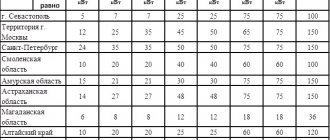Among people who have the opportunity to choose, the Toyota Land Cruiser Prado is very popular, its technical characteristics, fuel consumption, comfort and practicality attract fans all over the world. This frame mid-size SUV has been produced for more than 30 years and during this time has gone through 4 restylings, conquering almost the whole world.
In various modifications of the Prado, the consumption rate ranges from 5.7 to 17.6 liters of AI-92, AI-97, AI-98 gasoline or diesel. Our manufacturer presents cars with engines of 2.7 liters, 3.0 liters and 4.0 liters. It is this indicator that determines the gas consumption of the Land Cruiser Prado.
With 2.7 l engine
A 2.7 liter petrol engine was installed on the third generation model. Reconfiguration and modernization of the power plant made it possible to obtain different power for each series. In the 90 series car this figure is 150 hp, in the 120 series it reaches 163 hp, and for the 150 series it is 246 hp. The maximum speed on the highway is 175 km/h. According to the manufacturer, fuel consumption for this modification of the Toyota Land Cruiser Prado is 11 liters on the highway and 13.5 liters in the city.
As evidenced by owner reviews, the actual fuel consumption of the Prado 2.7 is significantly higher. It can reach 20 liters of gasoline in the city, which differs significantly from the figure indicated by the manufacturer. Interestingly, on the highway this figure is well within the 11 liters stated in the documentation. One of the reasons for this discrepancy is the condition of city roads, on which the driver constantly has to drive in lower gears and revise the gas in order to accelerate such a large car.
Toyota Land Cruiser Prado (90)
Land Cruiser Prado 90 was produced in three- and five-door station wagon body types. The range of SUV engines consists of two petrol and two diesel units. On gasoline: volume 2.7 l (power 150 hp), volume 3.4 l (power 180 hp) Turbodiesel: volume 3.0 l (power 125 and 163 hp)
Drivers' reviews of Land Cruiser Prado fuel consumption (90)
- Igor, Vologda. Toyota Land Cruiser Prado has been my long-time dream. And now the budget was enough to buy a car manufactured in 2001. Comfortable interior, many niches and pockets, when driving at high speeds it is better not to touch the hatch, there is a lot of noise. The A-pillars slightly interfere with good visibility. In general, the car is a beast! The consumption of a 2.7-liter engine is 14-15 liters in summer, 18-19 liters in winter.
- Ruslan, Moscow. I have a 1999 SUV, 3.0 l diesel engine, 130 hp. I’ve been driving it for two years now, I like the high ground clearance, huge trunk, accessible and inexpensive spare parts. Fuel consumption is at least 11 liters.
- Artem, Irkutsk. Land Cruiser Prado 1998, 3.4, AT, 4x4. A very reliable and powerful car, I accelerated it to 200 km/h, I couldn’t hear the engine noise, the gears shifted smoothly. Gasoline consumption per hundred kilometers is from 17 to 19 liters, but it’s worth it!
- Alexey, Orel. Land Cruiser Prado, turbodiesel, 125 horses, 3 liter engine. An excellent car for various rides, both in the city and in nature. If breakdowns do occur, the parts are found quickly and at normal prices. Diesel consumption on the highway is 10 liters, in the city – 14 liters.
- Denis, Vladimir. The car was made in 1998, had low mileage, and was in decent condition. Engine 2.7 l, 150 horses, automatic transmission. It rarely breaks, mostly on small things. High cross-country ability, but stiff suspension. A well-made interior, very comfortable for me as a driver. Gasoline takes 14-15 liters on the highway, 16-18 in the city.
With 3.0L engine
This model of diesel power unit is installed on the third and fourth modifications of the car; the engine power reaches 173 hp, which is quite enough for dynamic driving. At the same time, fuel consumption on the third modification of Toyota Land Cruiser Prado is 11.3 liters per 100 km in the city and 8.1 liters on the highway. In the fourth generation, this figure is 10.4 and 6.7 liters, respectively, which makes it the most economical option.
The main advantage of this power unit is its high build quality. Therefore, the costs of fuel consumption and repairs of the Land Cruiser Prado of this version are quite low, despite the fact that the diesel engine is demanding on maintenance. It is important that even with high mileage, these indicators do not exceed the standards specified by the manufacturer, which is confirmed by reviews from owners.
Fuel consumption Toyota Cruiser Prado
If buying a car doesn’t make you happy at all, it means you bought it for your wife, and the loan was issued to you.
Toyota Prado is a more off-road version of the regular Land Cruiser. Although they have many common parts, as well as the same platform, they differ in the motors they offer and other technical data.
Production began in 1990, and a total of four generations were produced, as well as several restylings. Toyota Land Cruiser Prado is very popular in our country, as it combines excellent dynamics, cross-country ability and a high level of comfort.
With 4.0L engine
For the third and fourth generations, a 4-liter gasoline engine was developed, the power of which in the third modification was 249 hp, in the fourth it was increased to 282 hp, which is the highest figure for production models. The fuel consumption of the third generation Toyota Prado is 16.7 liters per 100 km in the city and 9.8 on the highway. A modified version with higher power, which consumes 14.7 and 8.6 liters of gasoline, respectively.
The real fuel consumption parameters of the Toyota Prado of this version are confirmed by the manufacturer's data. There is a slight increase in consumption in winter, but this is normal for the domestic climate, especially in the third generation. Nevertheless, this version is very popular. It has excellent performance characteristics, high reliability, excellent dynamics and maneuverability. At the same time, fuel consumption for the 4-liter engine capacity of the Toyota Prado remains adequate.
Video: comparison of Prado 120 consumption with 2.7 and 4.0 l
Advantages and disadvantages of the car
The main advantages of this SUV include its safety and reliability, which allows you to operate it in any climatic conditions, feeling equally confident on the highway and in absolute off-road conditions. The large, roomy interior is comfortable and made of wear-resistant materials. The frame design provides the rigidity needed for off-road riding.
Another attractive feature is the rich equipment, ensuring the selection of the optimal option. Therefore, car enthusiasts are looking forward to the new 2021 Toyota Prado, in which fuel consumption is expected to be even lower. Reliability and high build quality ensure that the price of the machine will remain high over time, and this, in turn, makes it a profitable additional investment.
The frame design, in addition to its undoubted advantages, also has its disadvantages. They are associated with the complication of controllability at high speed. But stabilization systems cope with the problem quite successfully, and the driver just needs to get used to the nature of the car. Some owners complain about the insufficient dynamics of the 2.7-liter version, while fuel consumption on the Land Cruiser Prado 120 with a 4-liter engine is lower than on the less powerful version, which is also a problem for the cheapest modification of this car.
Owner reviews
- Vyacheslav, Volgograd. I’ve been wanting an SUV for a long time; I borrowed a 2008 Toyota Land Cruiser Prado from a friend with a 2.7 liter engine, fuel consumption is slightly higher than indicated in the documents. In the city it turns out to be about 18 liters, naturally, you need to make allowances for the quality of gasoline, although I try not to pour everything. But on the highway at a cruising speed of about 100 km/h, a quite acceptable 11 liters are consumed. Otherwise, I’m quite satisfied, it’s a comfortable, passable car.
- Ivan, Tyumen. I was looking for a family car suitable for our climate and roads. The cruiser fully satisfied all my needs and is the ideal option. The only problem is that the 2.7 liter engine is very voracious, especially in the cold season, in the city it takes 16-17 liters. Otherwise, everything is fine, so my wife and I are thinking about taking a Land Cruiser Prado diesel, whose fuel consumption, according to reviews, is several times lower. Although, the question remains how it will behave in winter in severe frosts.
- Sergey, Veliky Novgorod. I bought a Toyota Land Cruiser Prado 150 with a diesel engine, the fuel consumption is incredible, 9 liters on the highway and only 12 liters in the city! Despite the dimensions and weight, the volume of 3 liters is enough to feel great both on the road and off it. I don’t understand those who talk about the unreliability and capriciousness of diesel engines, the car covered almost 200 thousand km, and I just changed the oil and filters on time, no problems.
- Oleg, Krasnodar. In my opinion, the Land Cruiser Prado 150 has no downsides at all, diesel fuel consumption is simply amazing, on average it’s 8 l/100 km, and these are the characteristics of a passenger car. If you pick too hard, you might notice some rolliness when cornering, but for a body-on-frame SUV, the handling is simply fantastic. This is a rare case when you absolutely don’t want to change your car, because you’re happy with everything about it.
- Nikolay, Yaroslavl. When I bought a Prado 150 with a 4 liter engine, there were certain concerns regarding gasoline consumption and maintenance. They turned out to be in vain - you can’t think of a more reliable car; it’s enough just to change the oils and filters on time. As for consumption, for such a volume it is quite adequate - 16-17 liters in the city and only 11 on the highway, which is not a lot for such a large car.
- Alexander, Ufa. Owning a third generation Prado with a 4 liter engine. Comfortable, convenient, passable car, safe and reliable. Its only drawback is its gluttony, since it consumes 18, and in winter 20 liters per 100 km. But I’m not ready to sacrifice other advantages, so I’m already looking at the 2021 Toyota Land Cruiser Prado, whose fuel consumption is declared to be significantly lower with improved engine performance.
Toyota Land Cruiser Prado 120 and 150 fuel consumption 2.7, 3.0, 4.0
By kanistra Posted on 13/08/2015
Production of the Toyota all-wheel drive SUV with a monocoque frame began in 1987. In 2009, at the Frankfurt Motor Show, the 4th generation of Land Cruiser Prado was presented to the public under number 150, which, like its predecessor, was made in 3 and 5-door versions. The modern version of the car has a reinforced frame and differential locks.
- 2.1 Owner reviews about consumption
Toyota Land Cruiser Prado 120
Fuel consumption rate per 100 km
In the 3rd generation, this SUV was equipped with gasoline engines with a volume of 2.7 and 4.0 liters and a diesel engine with a capacity of 3.0 liters. Maximum speed – 163-175 km/h, average petrol consumption – 13.5-14.0 l, diesel – 10.8 l.
Real fuel consumption
- Stanislav, Sevastopol. I bought a brand new Prado in 2008, 249 hp, automatic transmission, 4.0 liter engine. After a mileage of 85 thousand, I can say that the main disadvantage of the SUV is its huge consumption - up to 22 liters of gasoline in the city with Conder. But on the highway at a speed of 120 km/h, the declared 11 liters are consumed.
- Artem, Moscow. I wanted to buy an SUV with a reasonable appetite. The choice fell on the diesel Land Cruiser 120. Built in 2004, 3.0d engine, manual. The car is just a tank on wheels - you don’t even feel the holes, it’s roomy and heavy. In the city, up to 13 liters of diesel are burned, on the highway no more than 10 liters. I’m also pleased with the cheap maintenance, although I’ve only changed tires and oil the entire time.
- Danila, Taganrog. Toyota Land Cruiser Prado 3rd generation is just a beast. I picked up a 2008 build with a 2.7-liter manual engine, and I still can’t get enough of it. Over the past 3 years, only the gasoline filter and oil have had to be changed. Regarding the engine’s appetite, about 9 liters are burned on the highway, in the city almost 2 times more.
- Anton, Chelyabinsk. I had a Toyota Land Cruiser Prado 120 from 2005 to 2008. I liked it for its exquisite design, ergonomics, power-to-efficiency ratio of the 4.0 engine. Consumption in summer is 16 liters, in winter 19-21 liters. Outside the city, 12-13 liters fit easily. Of the minuses, I remember the incomprehensible autobucking and anti-skid - it was very difficult to get used to.
- Alexander, Khabarovsk. I took a used 2006 Cruiser Prado in the 120th body. The car has never failed yet. The main thing is to fill the 3-liter engine with high-quality diesel. In 6 years of operation there have been almost no serious problems, only small things - wear of the stabilizer bushings, the supports turn sour. Average diesel consumption is 11 liters.
- Murat, Tambov. In 2008, my wife and I took a brand new car from the dealership. SUV with a 2.7 liter engine and automatic transmission. I like everything except the expense, but there’s nothing to be done - they knew what they were buying. After running in, it turns out to be up to 11 liters on the highway and around 18 liters in the city cycle. A bit much, but there are more advantages - the car is well stuffed with various gadgets.
- Victor, Omsk. Land Cruiser Prado 120 4.0 liters, year of manufacture 2004. For our roads this is the best option: cross-country ability, reliability, cheap components and adequate consumption (10 liters on the highway and 15 in the city, in winter + 2 liters). The car has almost no drawbacks, except for the inconvenient heating and mirror control buttons, as well as the lack of support for a USB flash drive.
- Peter, Belgorod. My parents gave me a brand new 2004 Prado 120 with a 2.7 engine and automatic transmission for my birthday. The mileage is now 183 thousand and the car still drives like new. With such an engine under the hood, Russian roads are not scary at all. But this has its price - high gas mileage. In the city all 20 liters are spent, on the highway about 15 liters.
- Evgeniy, St. Petersburg. I received a 2005 diesel version with an automatic transmission as a gift. Japanese quality speaks for itself - the 120th Prado Cruiser is simply indestructible. Well, if you can do this, then spare parts are always available and always cheap. As for the diesel engine, everything is fine - 13 liters for such a monster is not a waste.
- Nikolay, Kostroma. My father and I brought a Land Cruiser Prado 120, assembled for the Gulf countries. The 2.7 engine with manual transmission perfectly pulls a huge SUV where other cars simply cannot pass. The car was produced in 2009, comfortable and ergonomic. It just consumes the same amount of fuel as the 4-liter version - up to 14-15 liters in the combined cycle.
- Andrey, Moscow. Land Cruiser Prado 4.0 AT, 2007 I bought it with a mileage of 120 thousand kilometers. This is my fifth car and it is the best I've ever owned - a reliable SUV for all roads and all weather conditions. In terms of consumption in the city, it burns about 19 liters of gasoline, and on the highway around 14 liters - for such dimensions and power this is quite normal.
- Ilya, Magnitogorsk. Before the 120th Land Cruiser, my wife and I drove an old 90th model. No problem with this one. The 3.0 diesel engine pulls out great, the ride is smooth, the dynamics are 5 plus. For me there are no disadvantages, but even with this size of the car the engine could consume less than 13.5 liters in the city.
Toyota Land Cruiser Prado 150
Official information
The Land Cruiser 150 generation model range also featured power units with volumes of 2.7, 3.0d and 4.0 liters. Maximum speed is 165, 175 and 180 km/h, respectively. Average consumption – 12.4-8.5-11.7 l.
Other cars: VAZ 21124 1.6 16 valves fuel consumption per 100 km.
Owner reviews about consumption
- Slavik, Voronezh. I've always only bought jeeps. So the 150th Land Cruiser became my 5th car. I bought a restyled 2013 model with a diesel engine and automatic transmission. For 2 years, not a single breakdown - the Prado fully lives up to its reputation. Diesel consumption in the city is 10.1 liters, on the highway - 7.6 liters. Particularly pleasing is the high ground clearance and all-wheel drive.
- Vladimir, Orel. Land Cruiser Prado 2.7 AT, 2010. In severe frosts it starts the first time. I bought it 3 years ago for trips out of town - fishing, forest, hunting. So, with such an SUV you don’t have to be afraid of not getting through somewhere. It picks up speed a little slowly, but this is not critical. About 12.7 liters of gasoline are consumed per 100 km in the combined cycle.
- Alexey, Kharkov. We gave a Prado 150 2012 as a wedding gift. A beautiful big car with a moderately powerful engine. The 2.7-liter copes with its task - the “tank” accelerates to the stated 165 km/h, consuming 15 liters per 100 km in the city, and 11 on the highway. The main disadvantage is expensive maintenance and frequent skidding on bumps, you need to be on guard all the time.
- Pavel, Novgorod. Land Cruiser Prado 150, 3.0d (built in 2013). When buying an SUV, my wife and I argued for a long time, but now we both understand that the car is simply ideal in all respects: an economical diesel engine with reasonable consumption (8.5 liters on average), cross-country ability and a simply huge interior. The only irritation is the weak stabilization mechanism - for such a price the quality could be better.
- Aram, Rostov. After driving the 150, I immediately realized that I had to buy myself such an SUV. I took it with a 2.7 liter petrol unit. The car has a considerable appetite (city 16 liters, highway – 11). In winter it warms up quickly, but consumes up to 19 liters. A good car for traveling through impassable areas.
- Mikhail, Lipetsk. When buying this Land Cruiser, at first I was very worried whether 2.7 liters would be enough for city trips. Well, after the acquisition, all fears went away - the animal under the hood does its job, while spending from 12 to 20 liters of gasoline, depending on the driving style. If you don’t use too much gas, you can get by with 15 liters. In 2 years of ownership I have not yet found any cons.
- Vitaly, Chernyanka. I don’t know why people like the Prado 150 so much. As for me, I have never seen a worse SUV - bad air conditioner, low-quality plastic, high gas consumption (13-14 liters on average), ill-conceived Shumka. It picks up speed slowly, but rides smoothly and has good handling. I think I was a little hasty with the purchase. Build 2012.
- Sergey, Astrakhan. There is no point in listing all the advantages of the 4th generation Toyota Prado. It’s easier to name the shortcomings - poor sound insulation and that’s all. The 3.0 liter diesel engine with manual transmission, high-quality assembly and elegant appearance set the SUV apart from other car brands. In terms of consumption, everything is as stated by the manufacturer - 9.8 in the city and 7.3 liters on the highway. Build 2009.
- Mikhail, Moscow. I started driving for 30 years, I had different cars, but never SUVs. After the 150th Cruiser I don’t want anything else. A powerful engine, stylish design and a very spacious interior are just any man’s dream. Slightly poor visibility when turning, but this is a minor issue. Average consumption is 13 liters.
- Yuri, Naberezhnye Chelny. We were looking for a reliable and strong car and found it - the 4th generation Prado makes us happy every day. A powerful 2.7-liter engine, good service, excellent cross-country ability - these are the main advantages, but not all of them. Gasoline consumption on average does not exceed 13 liters, sometimes even 12, depending on the operating stove and speed. Build 2013, automatic transmission.
- Sergey, Tula. Oh, and I suffered with this Cruiser for 2 years - a burnt out clutch disc, bad paint and some kind of defective manual gearbox. Although there are no problems with the 2.7 engine - it pulled 12.3 liters at the beginning, and it still does. Of course, you feel confident behind the wheel, but for that kind of money you expect adequate returns.
- Boris, Yekaterinburg. I bought a Land Cruiser 150 from a dealer with a mileage of 25 thousand km. So far the flight is normal. I like the way the engine roars—you can immediately feel the power. The stove even warms up too well in winter - when the frost is 30 degrees, I can sit behind the wheel in just a shirt. About 7 liters are spent outside the city and up to 10 liters within the city - the norm for a diesel engine in such a large car. In winter + 2-2.5 liters on top.











